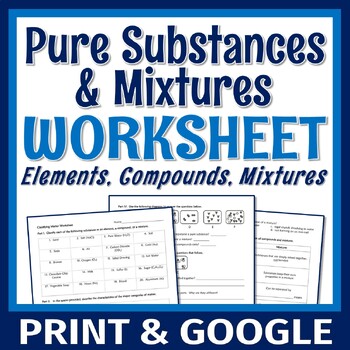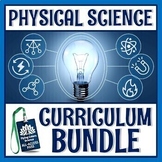Classification of Matter Worksheet Elements Compounds Mixtures
Flying Colors Science
4.8k Followers
Grade Levels
6th - 8th
Subjects
Resource Type
Standards
NGSSMS-PS1-2
NGSSMS-PS1-1
Formats Included
- PDF
- Google Apps™
- Easel Activity
Pages
3 pages
Flying Colors Science
4.8k Followers

Includes Google Apps™
The Teacher-Author indicated this resource includes assets from Google Workspace (e.g. docs, slides, etc.).
Easel Activity Included
This resource includes a ready-to-use interactive activity students can complete on any device. Easel by TPT is free to use! Learn more.
What educators are saying
This is a great resource for students to understand the differences between pure substances and mixtures.
I was able to leave these worksheets with a substitute and my students were able to successfully complete them. The instructions were clear and the material was laid out in a way students needed minimal help to complete. Thanks so much.
Also included in
- Looking for HIGH-QUALITY and NO FLUFF worksheets for physical science? SAVE OVER 40% on this MEGA BUNDLE of rigorous science worksheets for middle school!You'll receive 25+ worksheets with 65+ content-dense pages. These straightforward worksheets review and reinforce physical science topics. Each woPrice $49.99Original Price $96.46Save $46.47
- Never search for "something to do tomorrow" ever again! This bundle contains PRINT AND GO lessons, NO PREP activities, LOW PREP labs, and ENGAGING articles to supplement and thoroughly enhance a physical science course. Every included resource is easy to implement, standards-based, and high-quality.Price $399.99Original Price $671.34Save $271.35
- SAVE MORE THAN 50%! This bundle includes everything needed for students to learn to classify matter into elements, compounds, and mixtures, as well as be able to compare pure substances versus mixtures. All of the work has been done for you - from start to finish! These resources form a COMPLETEPrice $30.00Original Price $63.42Save $33.42
- SAVE 50% on a comprehensive, high-quality matter and chemistry unit! This bundle includes every resource we use to teach atoms, elements, the periodic table, classification of matter (pure substances versus mixtures), physical and chemical properties, and physical and chemical changes. All of the wPrice $93.50Original Price $187.58Save $94.08
Description
3-page classifying matter worksheet: Classify elements, compounds, and mixtures review. This middle school activity was designed as an overall review for a unit on elements, compounds, and mixtures.
Includes both PDF and Google Slides versions!
⭐ Find this activity in our COMPLETE CLASSIFICATION OF MATTER UNIT!
50 Questions cover the topics:
- Smallest unit of elements (atoms) and compounds (molecules)
- Differences in the characteristics of pure substances and mixtures
- Distinguishing between diagrams of elements, compounds, and mixtures
- Recognition that compounds have characteristic properties
Teacher Notes:
- Check out our COMPLETE CLASSIFICATION OF MATTER UNIT!
- Covers NGSS Standard: MS-PS1-1
- INCLUDES ANSWER KEY.
- Please note: this resource is not editable.
Total Pages
3 pages
Answer Key
Included
Teaching Duration
N/A
Report this resource to TPT
Reported resources will be reviewed by our team. Report this resource to let us know if this resource violates TPT’s content guidelines.
Standards
to see state-specific standards (only available in the US).
NGSSMS-PS1-2
Analyze and interpret data on the properties of substances before and after the substances interact to determine if a chemical reaction has occurred. Examples of reactions could include burning sugar or steel wool, fat reacting with sodium hydroxide, and mixing zinc with hydrogen chloride. Assessment is limited to analysis of the following properties: density, melting point, boiling point, solubility, flammability, and odor.
NGSSMS-PS1-1
Develop models to describe the atomic composition of simple molecules and extended structures. Emphasis is on developing models of molecules that vary in complexity. Examples of simple molecules could include ammonia and methanol. Examples of extended structures could include sodium chloride or diamonds. Examples of molecular-level models could include drawings, 3D ball and stick structures, or computer representations showing different molecules with different types of atoms. Assessment does not include valence electrons and bonding energy, discussing the ionic nature of subunits of complex structures, or a complete depiction of all individual atoms in a complex molecule or extended structure.










